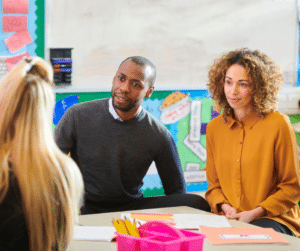Parenting, especially for children with unique needs or challenges, often requires a village. Part of that village is comprised of therapists and teachers who play pivotal roles in shaping a child’s developmental journey. However, ensuring all the parties are on the same page can sometimes be a challenge. In this article, we will discuss parent collaboration with therapists and teachers for a unified approach and share suggestions about how to achieve a unified approach.
The Importance of Collaboration
When parents, therapists, and teachers collaborate effectively, it presents a consistent and unified approach to the child’s care and education. Such consistency can:
- Accelerate Progress: A child receives the same focus and stimulation from all parties, reinforcing learning and therapeutic interventions.
- Prevent Confusion: Avoiding contradictory approaches minimizes potential confusion for the child and maximizes likelihood of progress.
- Enhance Support: A strong support network means more learning opportunities, resources, insights, and tools to benefit the child.
Potential Challenges in Collaboration
While collaboration holds numerous advantages, achieving it is not always straightforward:
- Differing Perspectives: Parents and professionals might have their own perspective about what’s best for the child, based on their training and experiences.
- Communication Barriers: Busy schedules can hinder regular communication between the parties.
- Mismatched Expectations: Parents and professionals might have different expectations or goals.

Parent’s Role: Bridging the Gap
Parents are the common thread connecting therapists and teachers. As such, they hold a unique position to:
- Share Information: Relay observations, insights, challenges, and successes from home to school and therapy, and vice versa.
- Clarify Goals: Ensure everyone is working towards the same milestones.
- Advocate: Represent their child’s best interests in all settings.
Strategies for Effective Collaboration
- Recognize Your Important Role on Your Child’s Educational Team: Share your insights, observations, and goals for your child.
- Regular Communication: Set up periodic meetings or touchpoints to discuss progress, strategies, and concerns.
- Acknowledge Professional Expertise: Tap into the knowledge, experience, and skills each professional brings to the table.
- Stay Open-minded: Be willing to adapt and to encourage others to adapt and try different strategies for the child’s benefit.

Troubleshooting Difficulties
If issues arise:
- Seek Clarification: Misunderstandings can be resolved by seeking clarity and open conversation.
- Compromise: Be willing to meet halfway to achieve the best outcome for the child.
- Third-party Mediation: If conflicts persist, consider bringing in a neutral third-party to help mediate.
FAQs
- How often should I communicate with teachers and therapists?
- Regularity depends on the child’s age, developmental level, and needs. Weekly updates may suffice, or daily check-ins may be more beneficial.
- What if a therapist and teacher disagree on an approach?
- Encourage open dialogue, seek to understand both perspectives, and work towards a compromise.
- How can I keep track of all the feedback and recommendations?
- Consider maintaining a collaboration journal, email thread, or using digital tools to document and consolidate information.
- Is it okay to change therapists or teachers if collaboration isn’t working?
- Always prioritize your child’s best interest. If a change is deemed necessary after all attempts at resolution, it’s a viable option.
- What if my perspective as a parent is overlooked?
- Assertively, respectfully, and confidently communicate your concerns and remind the professionals of your unique insight as the child’s primary caregiver. If needed, third party mediation may be an option.
- Can other family members be involved in this collaborative approach?
- Absolutely! Adult siblings, grandparents, or other key family members can offer valuable insights and support.
Additional Resources
- Parent Teacher Collaboration: Not All It Can Be | Psychology Today
- IEP: Students Benefit When We Collaborate | Edutopia
- Eight Ways Educators Can Collaborate with Parents | Psychology Today
- The Benefit of Parents and Teachers Working Together (verywellfamily.com)
Summary/Conclusion
Parent collaboration with therapists and teachers isn’t just a good-to-have; it’s essential for optimizing the well-being and development of children. By understanding the importance of a unified approach, recognizing potential pitfalls, and actively employing strategies as you collaborate with other team members, parents can ensure that their child gets the best possible education, support, and care.




0 Comments